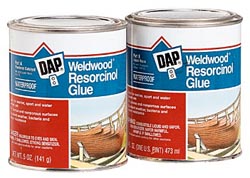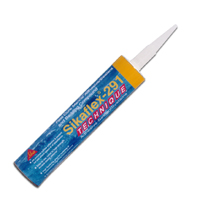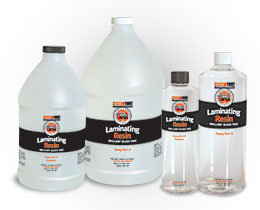We use glues more than any other fastenings in our boatbuilding, sure there are screws and nails, but in reality they are there to provide clamping pressure and to resist where there are very high local loads. I’ve built several boats that had no mechanical fastenings at all right up to the point where the rowlocks and rope cleats were fitted. How different from a few decades ago when perhaps a little white lead and linseed oil paste would be used to seal a garboard strake or where a plank landed against a stem.
It was only when really good waterproof glues became available in the 60s that fully glued structures became practical, and with those glues structural and marine grades of plywood totally changed the game for the amateur boatbuilder and made it possible to build quite substantial boats with relatively simple tools and ordinary handyman skills.
 For about 40 years there were perhaps three glues that were commonly used in boatbuilding, Epoxy resin glue, Resorcinol glue and Urea Formaldehyde glue. For about 40 years there were perhaps three glues that were commonly used in boatbuilding, Epoxy resin glue, Resorcinol glue and Urea Formaldehyde glue.
The first two of these are very well known today, the third one not so common. But there are all sorts of other glues beginning to appear, and there is much debate among home boatbuilders as to what the relative merits of some of these are.
As a technical advisor to the woodworking industry, working with companies that make large structural laminated wooden beams, I have had access to serious testing equipment, and in looking at all of the commercially available glues in an effort to find alternatives to the commonly used Phenolic resins (close relations to Resorcinol) and the Urea based glues used for indoor work I’ve tried and tested most of the many sticky stuffs that there are on the market.
You will be surprised at some of the results, I know that I was. I consider myself to be fairly resistant to the hyperbole and lies incumbent in advertising, but to find that my test results are so far from the advertised claims was sufficiently surprising to send me back to repeat the work.
My methods were fairly scientific, I used four different wood species, chosen for differing grain type and cellular structure. Starting with Pinus Insignis with its very open cells which transport moisture so well that penetration by fluids is very easy, to Teak with its cells filled with the tree's natural oils and several in between. Note that gluing Teak can be unreliable with any glue and requires specialist treatment before it will be reliable as glued material.
I ran several sets of tests on surface preparation, and found that in many cases sanded or abraded surfaces were much worse than a cleanly planed finish. I found that freshly planed was generally better than a surface planed days before, especially when machine planed, and the best glue surface of all was made by a dead sharp hand plane or cabinet scraper.
The reason for this was very evident when looking at the samples though a microscope, most of our common glues are mechanical bonds. That is they ooze into the interstices of the cell structure and set, creating a keying action rather like the old monkeys fist in a jar of peanuts effect. Sanding the surface, especially with a machine sander (think about the surface of plywood!) can heat the lignin that holds the wood cells together and form a film over the openings. Many of the big planing machines in sawmills make a beautiful finish, but if run a little long between servicing the cutter blades will so polish the surface that a good glue bond is near impossible.
This is unlikely on a surface machined at home, but a blunt jointer or planer can produce a finish that is not conductive to a good strong joint. If in doubt, test it!
Given effective surface treatment all of the samples tested were machined to a common size, hand planed on the glue surfaces, and glued in a climate controlled lab so all samples were made up and tested in a similar humidity and temperature.
The samples were then either run through a Hounsfield tensiometer or a Sharpf Shear block tester and the results recorded over a number of samples. The top and bottom 10% results were discarded to even out the result within a type, and each type of glue compared.
After all this was over (it tool several years of intermittent work) I came across a report in WoodenBoat by Dr Richard Jagels, professor of Forest Biology at the University of Maine in the USA which pretty much confirmed what it had taken me ages to put together. There are also other commercially available reports that are also consistent with both my report and the information that Prof Jagels published.
The results included a number of glues not commonly available to home boatbuilders, took several hundred pages to cover in full detail, but rather than encumber you with the dry and pedantic wordiness of a scientific report, I figure that a brief summary will be of interest .
Each glue is rated on a scale where WEST System Epoxy resin glue is 100. There are some stronger, and a lot weaker so the scale is comparative. Glues may also vary in strength from one manufacturer to another, or with variations in wood, so the results below, although I’ve tried to eliminate variables should be viewed as an indicative sample only.
Note that with two exceptions I’ve only included waterproof or water resistant glues used in boatbuilding. Glues such as Cyanoacrylates (superglue) are common, but not generally used in large enough quantities to be effective in boatbuilding. I’ve not tried to make this a comprehensive list, just to cover the common ones.
 Polysulphides Polysulphides
Usually sold in gun cartridge form and used as an adhesive sealant. Black or white sticky stuff for stopping up leaks! Very sticky, some will even stick to wet surfaces, and useful in “Quick and Dirty Boatbuilding” contests or for windows, under fittings bolted to the deck, where a centercase needs to be proofed against a sharp shock or where a seal needs to be made around a mast or such where it goes through the deck.
Strength, about 45 /100. If you are building a boat with this stuff, best just use it for the purpose for which it is sold, a sealant with limited adhesive properties.
Polyurethanes - foaming low density.
Often sold with a label that has a small version of King Kong on it and the slogan, “the world’s toughest glue”. (I’m being wary of lawsuits here but note that several other testers have produced the same results).
I use this quite a lot, but am very careful where. For example I have laminated oar blades, flat laminated plywood panels, and other items where the surface available to glue is very large in comparison to the force involved. I had several failures before getting mad and doing the testing, it came out as below, and since then I don’t recommend it even though its very easy to apply .
Strength, about 55/10
Polyurethane, reinforced (construction glues used in house building)
Similar in some ways to the Polysulphide glues but sold to fasten things together. Some are reinforced with microscopic fibres that act a little like rebar in concrete which makes it stronger.
These glues are good for gluing plywood underlayment to house framing, and some will do that to frozen and wet wood! Very good for gluing house framing to cement, ceramics, glass, metals and painted surfaces. Great stuff, but not for structurally important joints in a wooden boat. I have successfully used it to plug big gaps in a quick and dirty repair that is backed up with woodscrews or bolts (ideal for an emergency patch on a plywood boat ) Check the strength before you consider it!
Strength. 58/100
Polyester resin adhesive fillers
Not intended for marine use, and rightfully so. The samples that I tested came apart very easily and the glue in bulk soaked up water at an alarming rate.
Strength, 34/100
PVA
The ordinary woodworkers white glue, and the surprise of the bunch. Although not waterproof, (see the two variations below) it was the strongest glue tested. It does though require good surface prep, and a high clamping pressure. I don’t use it for boatbuilding, but have included it so if anyone asks you, you will be able to impress them by telling them that PVA (according to that lunatic boat designer down there in New Zealand) is the strongest commonly available glue around.
Strength, 122/100
Aliphatic PVA
Very similar to ordinary white PVA but yellow in colour, not quite as strong and although not sold as moisture resistant as the white PVA. I built a couple of kitchen chopping boards and ran them through the dishwasher on high temp rinse. They are several years old now, and have not come apart yet! I don’t recommend them for boatbuilding, but the test suggests that it’s a lot better than you might think.
Strength, 118/100
Cross linked PVA
This requires a catalyst to be mixed with it, and is listed as “water resistant”. When mixed it is much like ordinary PVA in use, requiring accurate fits and high clamping pressures its very strong when used appropriately and leaves a perfectly clear glue line which can be useful when building a yacht finish interior.
Strength, 118/100
Resorcinol
For the two decades between the end of World War 11 and the middle 60s when epoxy glues became readily available Resorcinol (a Phenol formaldehyde variation) was the boatbuilding glue of choice. It is very strong, is easy to use, has a reasonable pot life and cleans up with water. I still use it, as to many commercial builders and its close sister product is used to make the waterproof plywood that is the essential material for many of our designs, and most structural wooden beams used outdoors and in finger jointed products for exterior use.
Strong, easy to use but requires good close fits and a high clamping pressure to get the best result.
Strength, 112/100
UF
Weldwood, Aerolite and quite a few other brands sell this water resistant glue although the polyurethanes are making an impact in its main market of hobby woodworking so its not as common as once it was. Its easy to use, Aerolite requires a powder to be mixed with water to make a jelly like paste, then an acid catalyst can be either mixed or applied to one piece with the resin on the other. As with many other types of glue, good fitting joints and a high clamping pressure is required.
Clear glue line, easy to use, long pot life, good stuff!
Strength, 106/100
MUF
As above, but with melamine added to improve its water resistance, it was once very popular for small boats and for interiors. Hard to find but good stuff!
Strength, 106/100
 EPOXY EPOXY
The most common glue in use for boatbuilding today. Gap filling in ways that builders in the past find hard to comprehend, needing only very low clamping pressures, and with the use of appropriate hardeners fairly tolerant of temperature and humidity. Most suppliers can supply resin, with measuring devices and additives that make epoxy a boatbuilding “system” that can provide high and low density fillers, coatings to preserve and densify the surface, and of course glues in various viscosities and configurations.
“Epoxy “ is the most versatile of all adhesives for wooden or plywood boatbuilding, like many glues its somewhat toxic and should be used with appropriate protective clothing and good ventilation. It varies a lot from one manufacturer to another, hardener formulations vary, as do the many additives available, I suggest using product from a “name” company with a reputation to preserve, and who are prepared to provide advice and assistance when you need it.
Strength, 100/100
***** |

